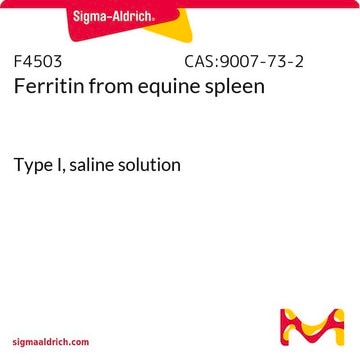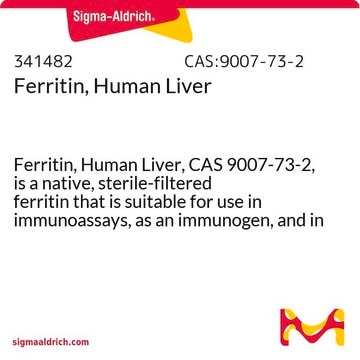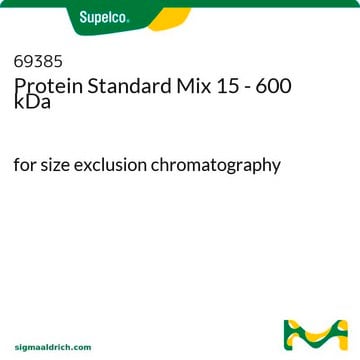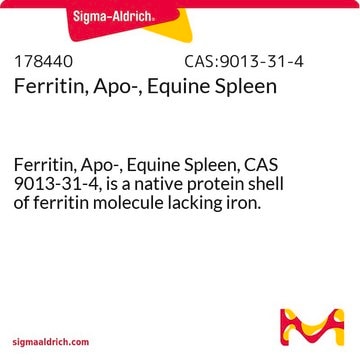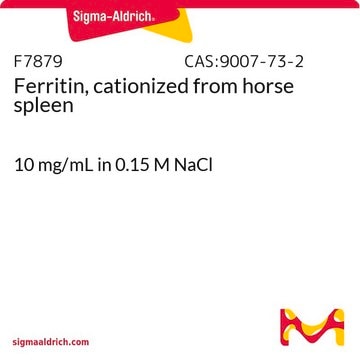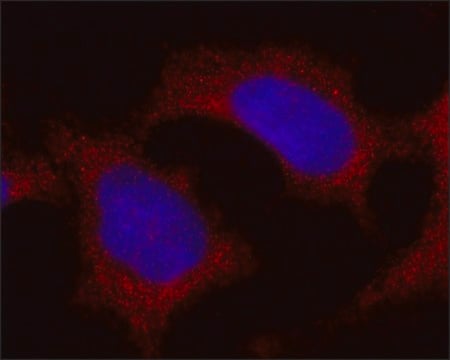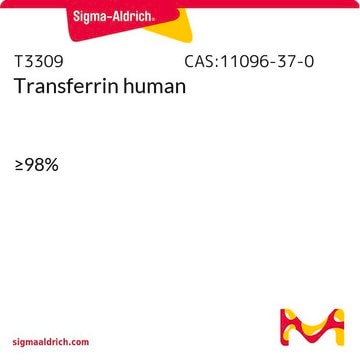F6879
Ferritin from human spleen
Type V, 10 μg/mL in 0.15 M NaCl, 10 mM Tris, pH 8.0, containing 0.1% sodium azide
Sign Into View Organizational & Contract Pricing
All Photos(1)
About This Item
Recommended Products
biological source
human spleen
Quality Level
sterility
sterile-filtered
type
Type V
form
liquid
packaging
vial of 2 μg
concentration
10 μg/mL in 0.15 M NaCl, 10 mM Tris, pH 8.0, containing 0.1% sodium azide
storage temp.
2-8°C
Gene Information
human ... FTH1(2495) , FTL(2512)
Application
Ferritin is an iron storage protein that plays a central role in iron metabolism, and may be elevated in inflammatory or malignant diseases. It has been used in studies as an indicator of body iron supply, but may prove inaccurate in in the presence of chronic inflammation.
Biochem/physiol Actions
A ubiquitous iron storage protein that plays a key role in iron metabolism. It serves as an intracellular iron reserve (particularly in spleen, liver, intestinal mucosa, and bone marrow) and functions in iron detoxification. Studies have shown that ferritin iron incorporation is mediated by a ferroxidase activity associated with ferritin H subunits and a nucleation center associated with ferritin L subunits. Release of iron from ferritin has an essential role in iron-dependent lipid peroxidation and may contribute to free radical-induced cell damage in vivo. Therefore, by binding iron, ferritin may function as an antioxidant.
Storage Class Code
10 - Combustible liquids
WGK
WGK 1
Flash Point(F)
Not applicable
Flash Point(C)
Not applicable
Certificates of Analysis (COA)
Search for Certificates of Analysis (COA) by entering the products Lot/Batch Number. Lot and Batch Numbers can be found on a product’s label following the words ‘Lot’ or ‘Batch’.
Already Own This Product?
Find documentation for the products that you have recently purchased in the Document Library.
Customers Also Viewed
Zonghuan Lu et al.
Journal of structural biology, 168(3), 388-395 (2009-08-18)
The goal of time-resolved cryo-electron microscopy is to determine structural models for transient functional states of large macromolecular complexes such as ribosomes and viruses. The challenge of time-resolved cryo-electron microscopy is to rapidly mix reactants, and then, following a defined
Rune J Ulvik et al.
Tidsskrift for den Norske laegeforening : tidsskrift for praktisk medicin, ny raekke, 133(8), 845-849 (2013-04-25)
A low supply of iron in the diet may result in iron deficiency and mild iron-deficiency anaemia in healthy individuals. Women are more susceptible than men because of menstrual iron loss. We compared the effect of a low dose of
Oner Ozdogan et al.
Acta cardiologica, 68(3), 299-305 (2013-07-26)
Cardiovascular involvement is the leading cause of mortality in patients with beta-thalassaemia major (beta-TM). This cross-sectional study was performed to evaluate the earlier cardiac damage in beta-TM by echocardiography, before left ventricular (LV) systolic dysfunction was observed. The study population
Sajid Soofi et al.
Lancet (London, England), 382(9886), 29-40 (2013-04-23)
Powders containing iron and other micronutrients are recommended as a strategy to prevent nutritional anaemia and other micronutrient deficiencies in children. We assessed the effects of provision of two micronutrient powder formulations, with or without zinc, to children in Pakistan.
Sara R Zwart et al.
The American journal of clinical nutrition, 98(1), 217-223 (2013-05-31)
Increases in stored iron and dietary intake of iron during space flight have raised concern about the risk of excess iron and oxidative damage, particularly in bone. The objectives of this study were to perform a comprehensive assessment of iron
Our team of scientists has experience in all areas of research including Life Science, Material Science, Chemical Synthesis, Chromatography, Analytical and many others.
Contact Technical Service
